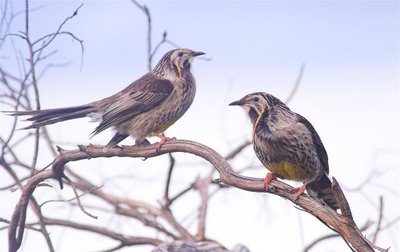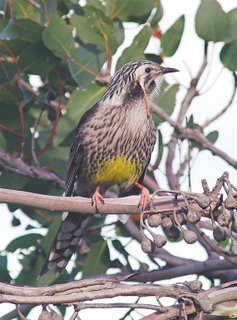
 I have been trying for sometime to get useable shots of the Yellow Wattlebird. On the face of it, it should have been easy as there are 5 pairs locally that I can find, without exception, at any time of the year. But YWBs spend much of their time high in a favoured eucalypt, frequently a Blue Gum (euc.globulus), their presence given away by their call. Although the literature suggests they roam widely during Winter, and many certainly do, the local pairs occupy and defend their territories throughout the year, maybe with less vigour during the non breeding season. On Bellerive Fort, the 19th century gun emplacement reserve, there are 2 resident pairs, which is where these shots were taken.
I have been trying for sometime to get useable shots of the Yellow Wattlebird. On the face of it, it should have been easy as there are 5 pairs locally that I can find, without exception, at any time of the year. But YWBs spend much of their time high in a favoured eucalypt, frequently a Blue Gum (euc.globulus), their presence given away by their call. Although the literature suggests they roam widely during Winter, and many certainly do, the local pairs occupy and defend their territories throughout the year, maybe with less vigour during the non breeding season. On Bellerive Fort, the 19th century gun emplacement reserve, there are 2 resident pairs, which is where these shots were taken.The Yellow Wattlebird is Australia's largest honeyeater, with the male reaching just short of half a metre in length and weighing up to 200 grammes, more than twice the weight of a Little Wattlebird. It is confined to Tasmania, and commonly seen in parks and gardens around Hobart. One fact, perhaps not so widely known, is that it was once considered a game bird. From the early colonial days, it was shot for the table, and a short season was opened each year, certainly upto the 1960s. It is now fully protected.
The image at lower left, is a wattlebird in full voice, declaring to others of its species and perhaps to
 other honeyeaters, 'this site is occupied'. In doing this, it produces a sound variously described as "a cork pulled from a bottle" and " a person vomiting". It's certainly an unforgetable sound!
other honeyeaters, 'this site is occupied'. In doing this, it produces a sound variously described as "a cork pulled from a bottle" and " a person vomiting". It's certainly an unforgetable sound!The image at the top is, from my perspective, memorable. It's unusual to see both birds together--they usually feed well apart and communicate by call, and to get a shot of them together was extremely lucky. It has a somewhat 'surreal' look about it, but it hasn't been retouched. It's interesting to compare the 2 birds, with the smaller female on the left.
2 comments:
Hi Alan,
These birds seem to have very long, pendulous wattles - longer than any I've seen, I think. Does anyone know if they keep growing throughout a birds life - in which case they'd be an indicator of age? Or perhaps they vary in length depending on a bird's nutrition. I seem to recall someone doing a study on length of wattles, but don't recall what the findings were. Maybe someone can remond me??
Hi Alan,
As far As I'm aware the wattles are a secondary sexual signal. They may engorge during their breeding season and in so provide an indication of fitness.
There have been very few studies on this bird as it is nomadic (difficult to track)outside the breeding season, so the info here is an assumption rather than something I'm certain of.
I don't believe wattles grow throughout their life span, but I assume that they respond to diet.
p.s. It's been a terrific season for the species - they are a favorite of mine. It's been a joy to watch them lately. A great place to locate nests is South Hobart rivulett track!
Cheers,
MARTIN PEPPERDAY
Post a Comment